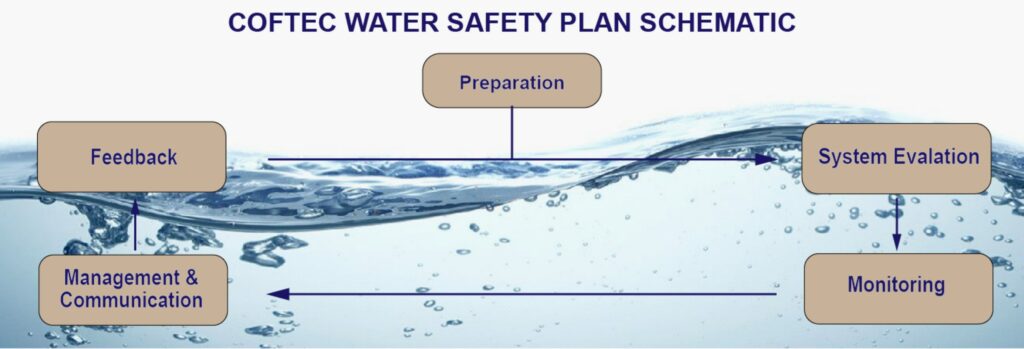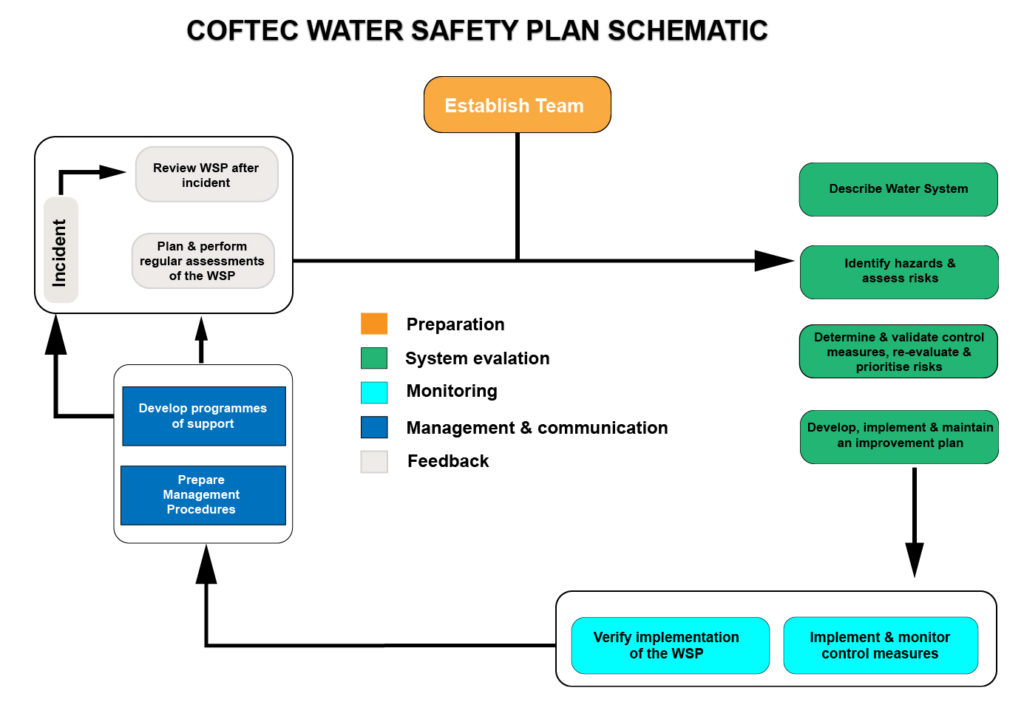
Blog
Water Safety Plans for Wastewater
Water Safety Plans are essential for ensuring access to clean water, not only for drinking but also for managing wastewater. Wastewater can pose a significant threat to public health and the environment if not treated and disposed of properly. Therefore, it is vital to implement Water Safety Plans in wastewater management. We have discussed the importance of a Water Safety Plan for Ingredient Water in a previous post. In this blog post, we will delve into the importance of Water Safety Plans for wastewater, and how they can help safeguard public health and the environment.
Water Safety Plans are designed to protect public health and the environment by ensuring the safety of drinking water and preventing water-borne diseases. Wastewater is any water that has been used and then discarded, including sewage, domestic wastewater, industrial wastewater, and stormwater. Water Safety Plans are often developed in response to specific threats, such as natural disasters or chemical spills. They typically address four key elements: water supply, treatment, distribution, and emergency response. Wastewater management plans are similar but focus on the safe disposal of wastewater rather than its treatment. Both types of plans are essential for protecting public health and the environment. Water Safety Plans ensure that drinking water is safe, while a Water Safety Plan for wastewater can prevent water-borne diseases and protect our water resources.
-
What is a Water Safety Plan?
A Water Safety Plan is a comprehensive document that identifies potential hazards and outlines the actions to be taken to mitigate those risks. It is usually developed by a team of experts who consider all aspects of water safety, including source water protection, treatment, distribution, and emergency response. The purpose of a Water Safety Plan is to ensure that potable water is safe to drink and that wastewater is properly treated before being released back into the environment. A Water Safety Plan is a living document that must be regularly updated as new information becomes available and as changes are made to water systems. It is an important tool for utilities and other organisations that manage water resources. A Water Safety Plan can help to ensure that these organisations are prepared to respond to water-related emergencies and that they are taking all necessary steps to protect public health.

-
What is the purpose of the plan?
A Water Safety Plan is a comprehensive document that identifies potential hazards and outlines the steps that need to be taken to ensure the safety of water supplies. The purpose of a Water Safety Plan for wastewater is to protect public health and the environment by preventing waterborne diseases and contamination. Waterborne diseases are caused by microorganisms that are present in water supplies. These microorganisms can cause severe illness and even death. Contamination of water supplies can also occur when chemicals or other pollutants enter the water. A Water Safety Plan outlines the steps that need to be taken to ensure the safety of water supplies. These steps include: Identifying potential hazards, Assessing the risks posed by these hazards, Developing control measures to mitigate the risks, Implementing the control measures, Monitoring the water quality adequate signage for all water hazards, and effective communication with the public about the risks posed by water hazards.
-
What are the benefits of having Water Safety Plans for Wastewater?
Water Safety Plans are crucial in ensuring the safe management of water, particularly in the context of wastewater. These plans provide a systematic and comprehensive approach to identifying, assessing, and controlling water safety risks. With a Water Safety Plan for wastewater in place, organisations can proactively manage potential hazards and prevent waterborne diseases from spreading.
One of the key benefits of having a Water Safety Plan for wastewater is that it helps to protect public health and the environment. It ensures that wastewater is treated and discharged safely, without posing any harm to human health or the natural environment. It also helps to reduce the risk of water pollution and contamination. A Water Safety Plan for wastewater promotes communication and coordination among stakeholders involved in water management. This includes water utility companies, local authorities, and community groups. By fostering collaboration, a Water Safety Plan improves the efficiency and effectiveness of response and recovery efforts in the event of a water-related incident. In summary, having a Water Safety Plan for wastewater is essential in ensuring the safe management of water, protecting public health and the environment, and promoting collaboration among stakeholders.
-
Who needs a Water Safety Plan?
A Water Safety Plan is a document that outlines how an organisation will ensure the safety of its water supply. It is applicable to any organization that supplies water for human consumption, whether it is a municipality, a private company, or a not-for-profit organization. The purpose of a Water Safety Plan is to prevent waterborne illnesses and protect public health. A Water Safety Plan contains information on the source(s) of water used by the organization, the treatment methods used to ensure the safety of the water, and the monitoring and testing procedures in place to verify the safety of the water supply. A Water Safety Plan is developed by conducting a hazard analysis of the water supply. This includes identifying potential hazards that could contaminate the water and assessing the likelihood and potential severity of these hazards. Once the hazards have been identified, the organisation develops and implements controls to mitigate the risks. There is no one-size-fits-all approach to water safety, and the best way to ensure the safety of your water supply is to develop a Water Safety Plan specific to your organisation. Coftec can help if you are unsure how to develop a Water Safety Plan to meet the specific requirements of your situation.
-
What are the components of a Water Safety Plan?
A Water Safety Plan is a comprehensive and systematic approach to managing water-related risks. It includes a set of risk management activities, such as hazard identification, risk assessment, and risk control. A Water Safety Plan also includes provisions for emergency response and recovery. The components of a Water Safety Plan vary depending on the size and complexity of the water system, and the type of risks present. However, all Water Safety Plans should include the following components:
• A water safety policy: This sets out the commitment of the water utility to providing safe water to its customers. The policy should address the roles and responsibilities of staff, and the procedures for managing water safety risks.
• A water safety team: This team is responsible for implementing the Water Safety Plan. The team should be interdisciplinary and include representatives from all relevant departments, such as water supply, wastewater treatment, and maintenance.
• The Water Safety Plan: This is a document that outlines the activities and procedures for managing water safety risks. The plan should be reviewed and updated on a regular basis, in response to changes in the water system or the risk environment.
• A hazard identification program: This program identifies potential hazards in the water system, and assesses the risks posed by these hazards.
• A risk assessment program: This program assesses the likelihood and consequences of water safety risks. This information is used to prioritize risks and develop control measures.
• A risk control program: This program implements controls to minimise the likelihood and consequences of water safety risks.
• An emergency response plan: This plan outlines the procedures for responding to water safety incidents. It should be regularly reviewed and updated, in line with changes in the water system or the risk environment.
• A monitoring and review program: This program monitors the performance of the Water Safety Plan and reviews the effectiveness of risk controls. This information is used to modify the Water Safety Plan, as necessary.
-
How to develop the Plan?
Water Safety Plans are essential for protecting public health and the environment by ensuring the safety of drinking water and managing wastewater. If wastewater is not treated and disposed of properly, it can pose a significant threat to public health and the environment. Therefore, it is vital to implement Water Safety Plans in wastewater management. These plans are similar to Water Safety Plans for drinking water but focus on the safe disposal of wastewater rather than its treatment. To develop a Water Safety Plan for wastewater, a team of experts must identify potential hazards, assess the risks posed by those hazards, and develop control measures to mitigate the risks. The plan should also include provisions for emergency response and recovery, adequate signage for all water hazards, and effective communication with the public about the risks posed by water hazards. Water Safety Plans for wastewater are living documents that must be regularly updated as new information becomes available and as changes are made to water systems. Coftec can help to develop a Water Safety Plan specific to your situation which will ensure the safety of the wastewater stream.

-
Why is it important to review and update your Water Safety Plan regularly?
It is important to review and update your Water Safety Plan for wastewater regularly to ensure that it meets the needs of your specific community and that everyone is aware of the dangers posed by the water. There are a number of reasons why it’s important to review and update your Water Safety Plan regularly. First, it’s important to make sure that the plan meets the needs of your specific community. Every community is different, and what works in one might not work in another. Second, it’s important to keep everyone in your community aware of the dangers posed by the water. Regular updates to your Water Safety Plan will help to ensure that everyone is up-to-date on the latest information and that they know what to do in case of an emergency. Third, review and updates to your Water Safety Plan can help to identify potential problems before they become serious. By regularly reviewing the plan, you can catch small issues before they turn into big ones. Fourth, water safety is an ever-changing field. New techniques and technologies are always being developed, and it’s important to keep up with the latest advancements. Regular updates to your Water Safety Plan will ensure that you’re using the best possible methods to keep your community safe. Finally, it’s important to review and update your Water Safety Plan because it’s the right thing to do. Water safety is a serious issue, and it’s important to do everything you can to keep your community safe. By regularly reviewing and updating your Water Safety Plan, you can make sure that you’re doing your part to keep your community safe.
Conclusion
Water Safety Plans are critical in ensuring that clean and safe water is accessible, not only for drinking but also for managing wastewater. Wastewater poses a significant threat to public health and the environment if not treated and disposed of properly. It is essential to implement Water Safety Plans in wastewater management to safeguard public health and the environment. These plans identify potential hazards, assess the risks, and develop control measures to mitigate the risks, ensuring that wastewater is properly treated before being released into the environment. Water Safety Plans are essential for protecting public health and the environment and should be regularly updated as new information becomes available. Therefore, all organisations that produce wastewater should develop a Water Safety Plan specific to their situation to prevent waterborne illnesses and protect public health.
Coftec specialises in providing guidance or solutions related to water safety plans for wastewater and ingredient water. If you have any questions or concerns related to this topic, please contact Coftec and we will help get the answers you need to ensure the safety and quality of your water.
